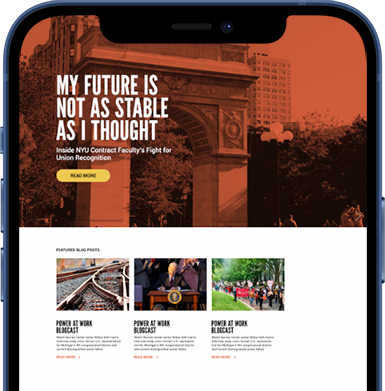This post is an edited interview of Johnnie Kallas, Director of the Cornell ILR Labor Action Tracker, conducted by the Labor Radio Podcast Network. The Power At Work Blog is a proud member of the network. We are especially pleased to support the network’s great work by welcoming back Johnnie Kallas to the Power At Work Blog. We interviewed Kallas in February 2023 about the Cornell ILR Labor Action Tracker’s 2022 Annual Report. In this interview, Kallas explains in greater detail how to use the Labor Action Tracker.
Johnnie Kallas: Thanks for having me again, my name's Johnnie Kallas. I'm a PhD currently affiliated with Cornell University’s ILR school, soon moving to the University of Illinois and Champaign Urbana beginning in January. But the tracker will go on, I can promise you all that. So I'm just going to briefly introduce the tracker, do a little bit of show and tell, and then I want to leave some time for any questions you all may have, and any ways that we can improve the tracker, if you all have any ideas.
So we began the labor action tracker project in January of 2021 to create a comprehensive database of strike activity and to serve two main purposes.
One is to create that database and provide reliable information on strikes. So, as some of you may know, the Bureau of Labor Statistics actually used to keep really excellent strike data until funding cuts by the Reagan administration in the early 1980s. Since then, they've only documented work stoppages involving 1,000 or more workers that last at least an entire shift and occur during a workday defined as a non-weekend, non-federal holiday. So, BLS really excludes the vast majority of strike activity across the country. We created our database to overcome that limitation and make that data publicly accessible to document strikes of all sizes by both union and non-union workers.
We're trying to amplify the voices of striking workers for our project on social media, which is the second primary goal. So whether that's trying to get workers out to picket lines, or just try and spread the news about strikes that maybe aren't in the mainstream press as often, that's very much a goal of ours as well.
Labor Action Tracker and Map, Cornell ILR School
Johnnie Kallas: So maybe you have seen the Labor Action Tracker. This is our map, which is an interactive map where we display our database. There's a few things I just want to point out.
First, we make a distinction between strikes and labor protests, which is somewhat academic, but I do think is important. We define a strike as a temporary stoppage of work led by a group of workers to enforce a grievance or advance a demand — so, basically, if there was an action or a protest that involved workers stopping work. It can be as short as this documented example of a 12-minute long work stoppage by bus drivers at a bus depot in Brooklyn, which anybody who relies on public transportation can understand that a 12-minute work stoppage is quite disruptive. As long as there's any sort of temporary stoppage of work on work time, we will label it as a strike.
We also keep track of protests, which doesn't get as much attention. It's not comprehensive, but we have well over 1,500 protests in our database. These are rallies, informational pickets, and other types of protests as well. You can obviously use the map to find different strikes in your area. I'll just go to the most recent one we documented from November 5th, a strike by I.B.E.W. members. This just gives you a sense of the different variables we track in relation to each strike.
IBEW Strike on November 5th, 2023. Documented in the Labor Action Tracker, Cornell ILR School
Johnnie Kallas: We document the employer, the labor union, the local industry, the address, the start and end date, whether the strike was authorized by union leadership, the demands, and the number of workers involved, if we have that information. And then we link to our sources.
I also should say that, on our social media, we put together monthly summaries of strike activity, which has been helpful. So please follow us at @ILRLaborAction on Twitter, which is where we put together those summaries each month. Then, we have an annual report where we'll release our 2023 version. There will be a considerable uptick, at least in the number of workers on strike from the last couple of years. We document strikes by a lot of variables, so not just the number of work stoppages, but by industry, duration, size, demand, unionization status et cetera.
To access the Cornell ILR School Action Tracker, click here.
If you have a strike to report that is not already on the tracker, click here.
If you want to hear Johnnie Kallas talk more about the action tracker, click here.

